Attached files
| file | filename |
|---|---|
| 8-K - 8-K - FIFTH THIRD BANCORP | d335543d8k.htm |
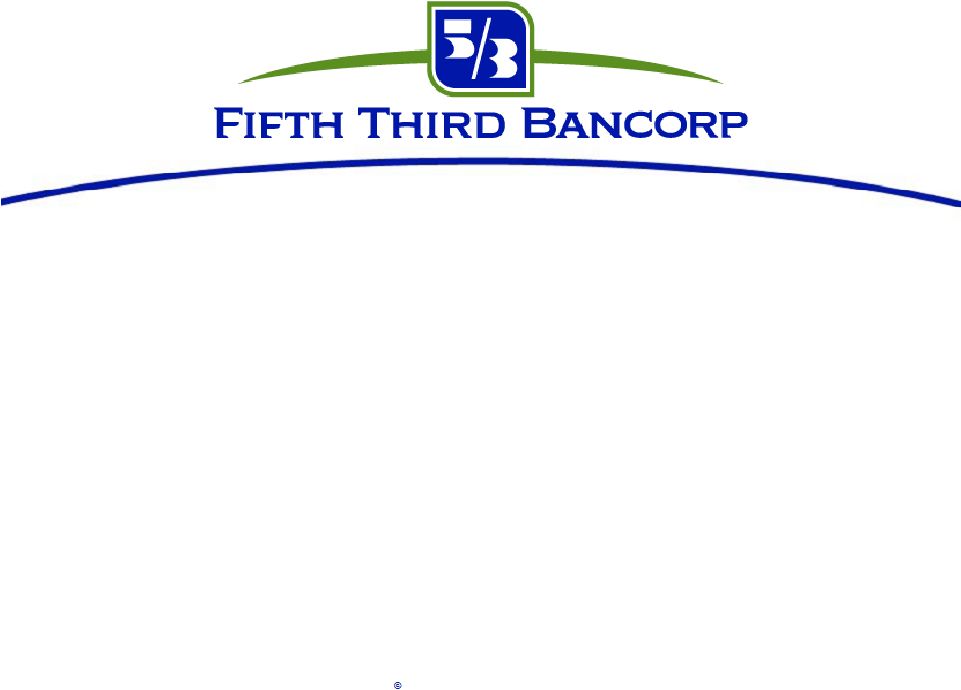 Fifth Third Bank | All Rights Reserved
Annual Meeting of Shareholders
April 17, 2012
Please refer to earnings release dated January 20, 2012
and 10-K dated February 29, 2012 for further information,
including full results reported on a U.S. GAAP basis
Exhibit 99.1 |
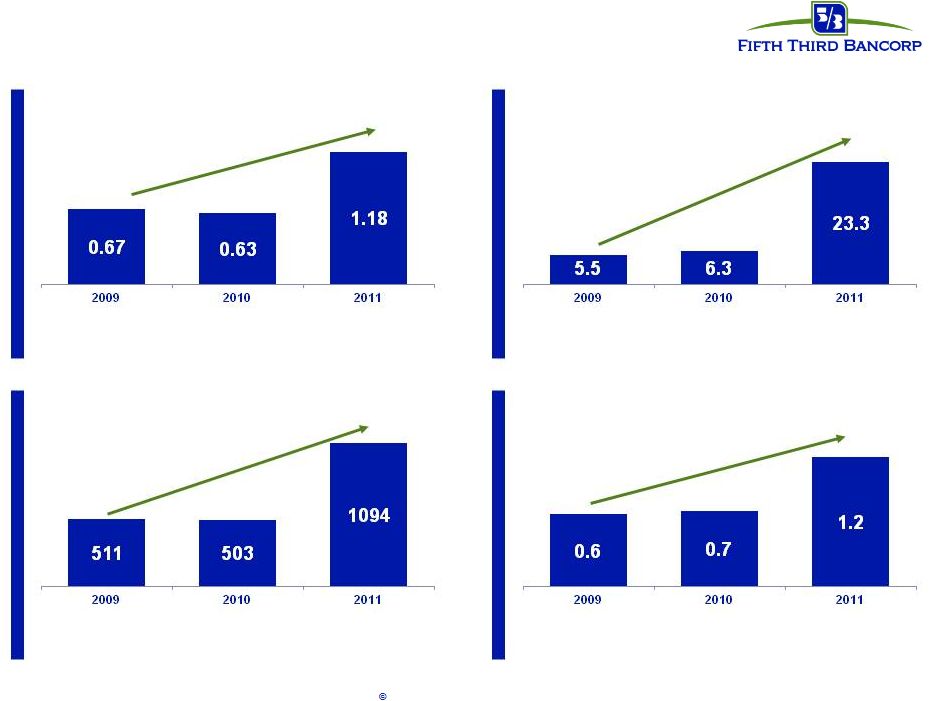 2011:
A year of strong performance Dividend payout ratio (%)
Diluted earnings per share ($)
Return on assets (%)
Net income to common ($)
Earnings per share nearly doubled
compared with 2010
Increased quarterly dividend twice during 2011
resulting in $0.32 annualized dividend
Net income available to common shareholders
more than doubled compared with 2010
ROA of 1.2% increased nearly 50 bps
compared with 2010
2
Fifth Third Bank | All Rights Reserved |
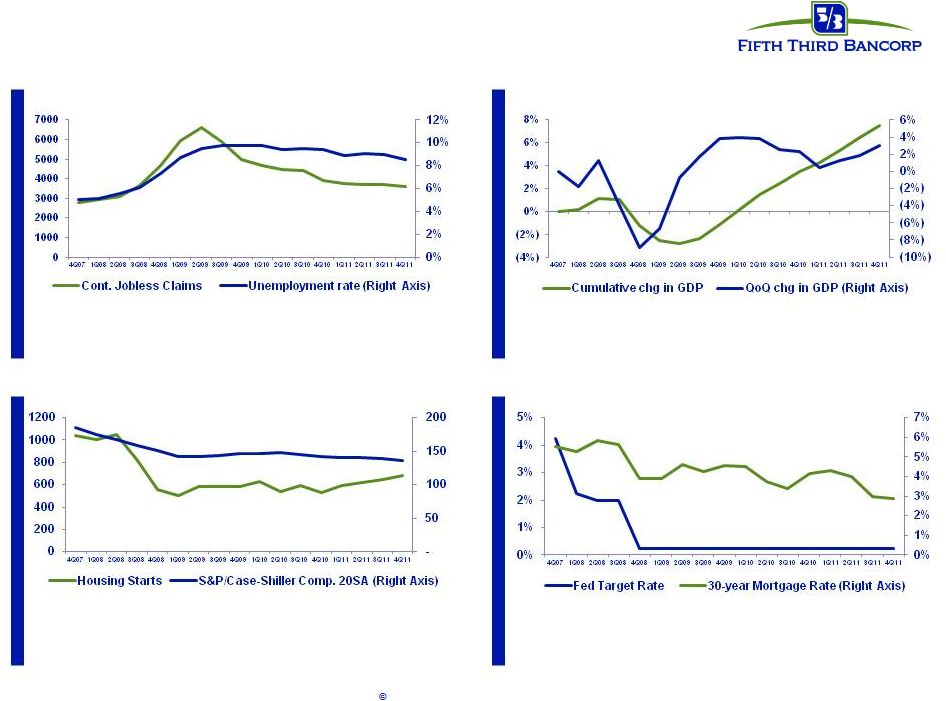 3
Fifth Third Bank | All Rights Reserved
The environment is improving…
but remains challenging
Gross Domestic Product
Employment
Rate Environment
Real Estate
Unemployment has declined, but still
remains elevated vs. pre-crisis levels
GDP has grown consistently
but sluggishly since 4Q08
Home prices have stabilized, but new
construction continues to lag
Prolonged low rate environment reduces value
of bank deposits and lowers asset yields |
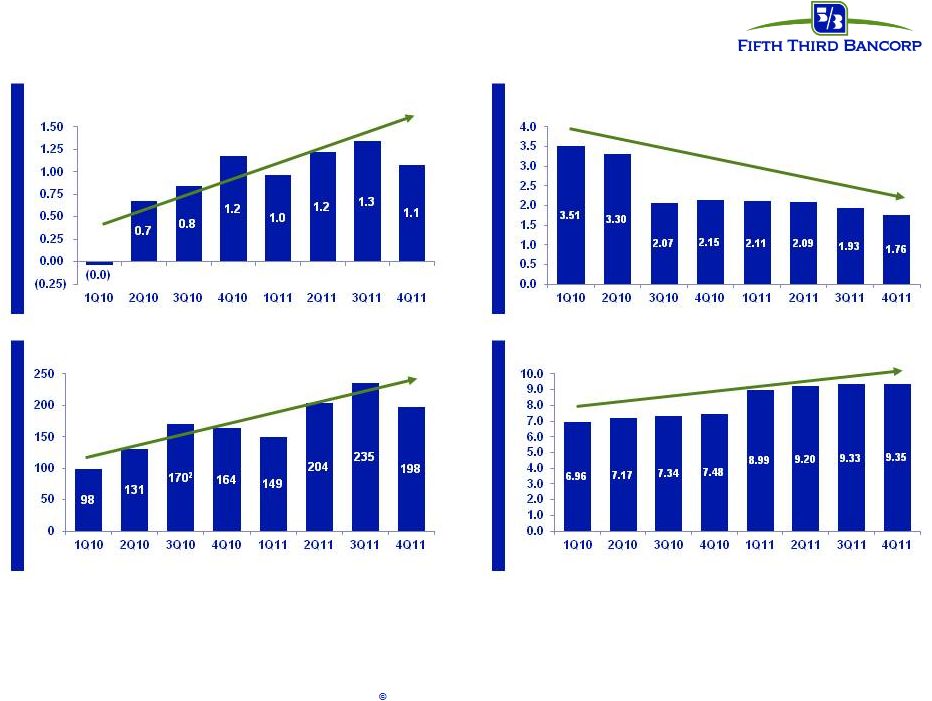 4
Fifth Third Bank | All Rights Reserved
We relentlessly pursue positive outcomes
1
Nonperforming
loans
and
leases
as
a
percent
of
portfolio
loans,
leases
and
other
assets,
including
other
real
estate
owned
(does
not
include
nonaccrual
loans
held-for-
sale)
2
Excluding $510mm net charge-offs attributable to credit actions
* Non-GAAP measure. See Reg. G reconciliation in the Appendix to the
presentation Tier 1 common ratio (%)*
Return on assets (%)
PPNR / Net charge-offs (%)*
NPLs / Loans
1
(%)
2011 was most profitable year since 2006 |
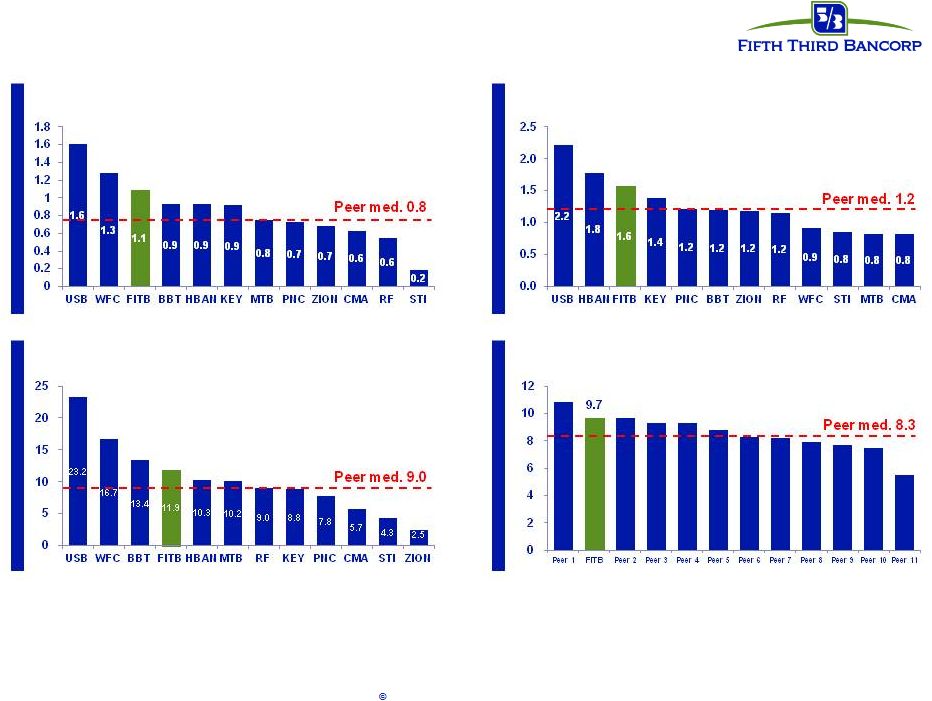 5
Fifth Third Bank | All Rights Reserved
We aim to set ourselves apart
4Q11 Tier 1 common (%)*
(adjusted for Basel III^)
4Q11 Return on assets (%)
4Q11 Reserves / NPLs (%)
4Q11 Return on tangible common equity (%)*
Industry leader in earnings power
Source: SNL Financial and Company Reports.
* Non-GAAP measure. See Reg. G reconciliation in the Appendix to the
presentation ^ Estimates based on current Basel III rules released by the
Basel Committee; actual rules subject to U.S. banking regulation. Assumes unrealized securities gains
included
in
Tier
1
common.
Not
adjusted
for
potential
mitigation
efforts. |
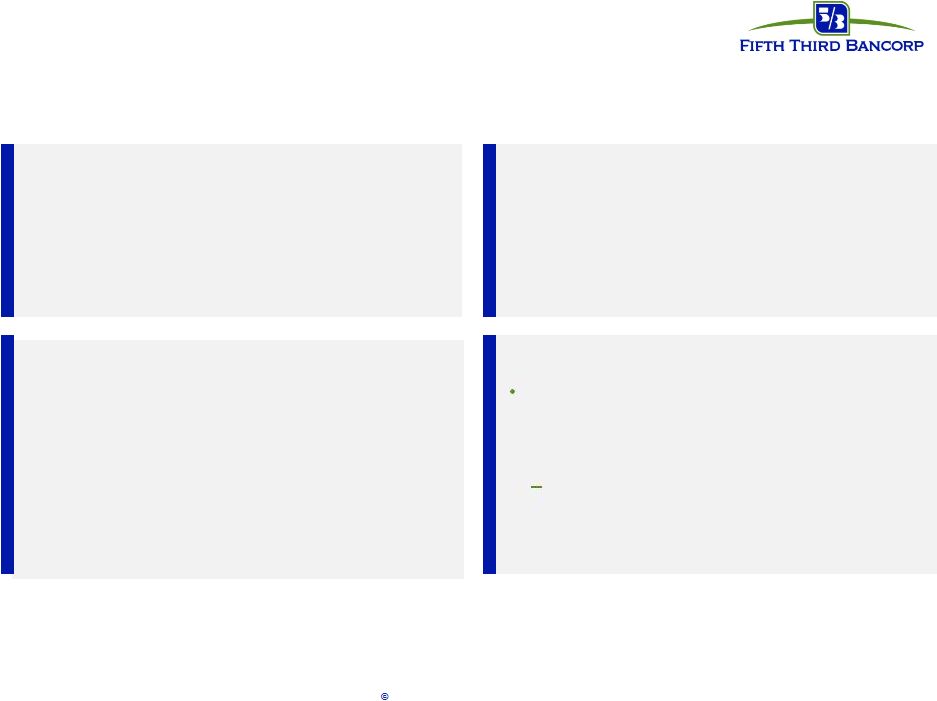 6
Fifth Third Bank | All Rights Reserved
We are focused on
effective capital management
* Subject to Board of Directors and regulatory approval
** Comprehensive Capital Analysis & Review by Federal Reserve
Organic growth opportunities
•
Support growth of core banking franchise
•
Continued loan growth despite sluggish
economy
Strategic opportunities
*
•
Prudently expand franchise or increase
density in core markets via disciplined
acquisitions or selective de novos
•
Expect future acquisition activity although
less likely in near-term
•
Attain top 3 market position in 65% of
markets or more longer term
Return to more normal dividend policy
*
•
Strong levels of profitability would support
higher dividend than current level
•
Move towards levels more consistent with
Fed’s near-term payout ratio guidance of
30%
Repurchases / Redemptions
*
Recommendations for increased shareholder distributions upon
Federal Reserve approval of capital plan**
Capital Deployment
Capital Return
Manage common equity in light of
regulatory environment, other
alternatives, maintenance of desired /
required buffers, and stock price
Initiate common share repurchases to
manage growing excess capital levels;
retain amount of common equity to
accommodate asset growth |
 7
Fifth Third Bank | All Rights Reserved
We are positioned well for industry changes
No significant changes to business model or asset mix
Traditional banking activities, consistent with direction of
financial reform
No direct European sovereign exposure;
very modest exposures overall
Little to no impact
Mortgage risks are manageable
No significant business at Fifth Third impaired during crisis
Dodd-Frank Act /
Basel III
Volcker rule
Effect of crisis on core
business
Mortgage Putback /
Litigation risk
Financial system
interconnectedness
European crisis |
 8
Fifth Third Bank | All Rights Reserved
You don’t get to new ideas
by using the same old ideas. |
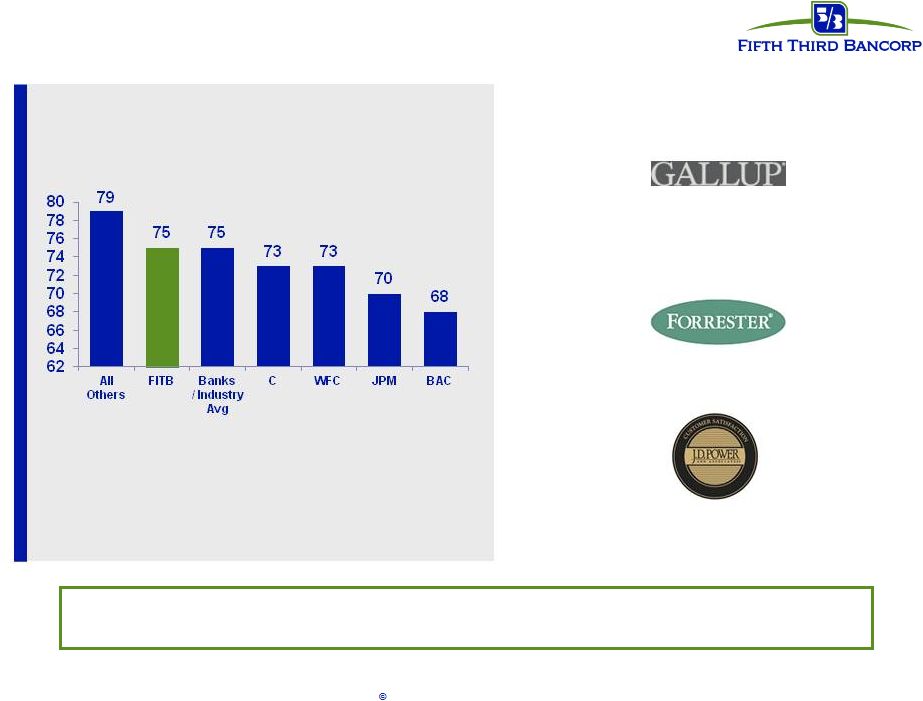 9
Fifth Third Bank | All Rights Reserved
We are focused on the customer experience
Fifth
Third
Bank
engaged
the
American
Customer Satisfaction
Index
(ACSI)
in
custom
research
projects
surveying
Fifth
Third
Bank
customers
in
the
3
quarter
of
2011.
In
the
surveys,
ACSI
used the same statistical methodology as the independently measured banks, Bank of
America, J.P. Morgan Chase, Wells Fargo, and Citigroup. The Customer Experience Index, 2012”,
Forrester Research, Inc., January 23, 2012
Consistently achieving leading customer satisfaction scores through focus
on providing valuable products and services at fair prices
Fifth Third outscored
the bank industry average
Fifth Third recipient of
“Great Workplace Award”
(March 2011)
Fifth Third improved
consistently over last 4 years
Third-Party Recognition
Fifth Third’s score was in line with the ACSI
Banks industry average (Bank of America,
Citi, Wells Fargo, J.P. Morgan Chase and an
aggregate of smaller banks)
2011 ACSI Scores
Customer Satisfaction Scores
rd |
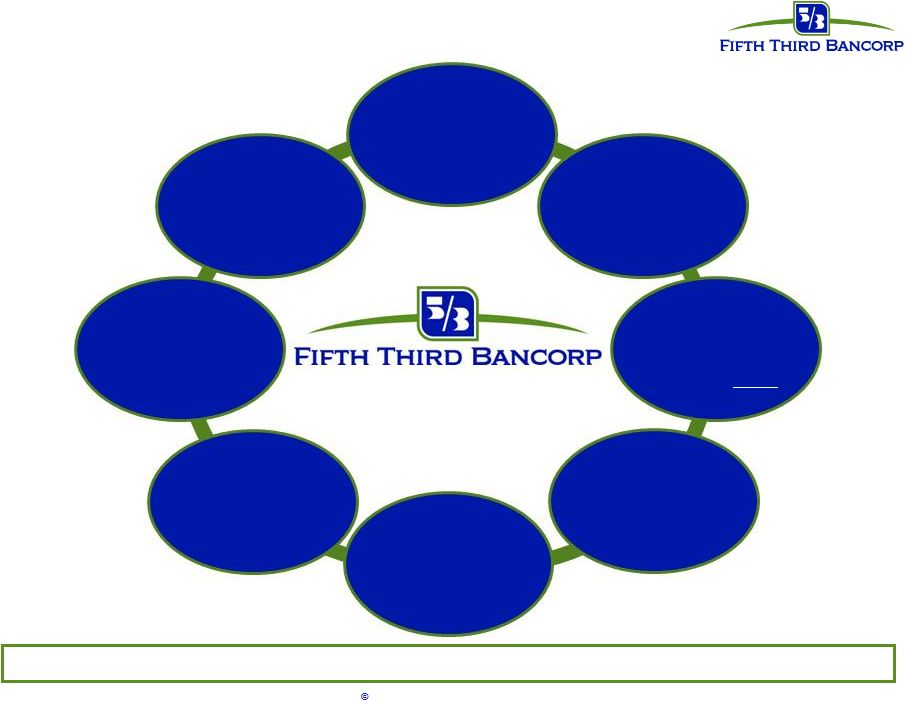 10
Fifth Third Bank | All Rights Reserved
Well-positioned for success and leadership in new banking landscape
Resilient business model provides strength
Strong levels of
profitability
Broad-based
credit
improvements
Exceed fully
phased-in Basel
III capital
standards today
All crisis-era
government
support
programs exited;
no TLGP
No significant
business at Fifth
Third impaired
by crisis
Continued
investments to
maintain and
enhance
revenue-
generation
Disciplined
expense control
Traditional
banking focus
consistent with
direction of
financial reform |
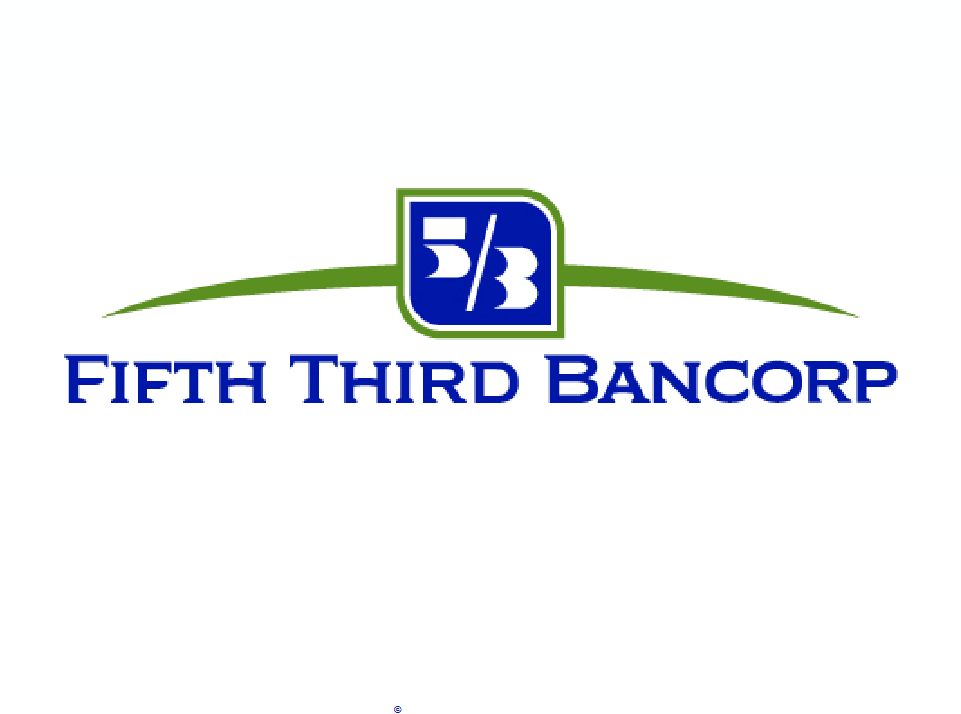 Fifth Third Bank | All Rights Reserved |
 12
Fifth Third Bank | All Rights Reserved
Cautionary statement
This report contains statements that we believe are “forward-looking statements” within
the meaning of Section 27A of the Securities Act of 1933, as amended, and Rule 175 promulgated
thereunder, and Section 21E of the Securities Exchange Act of 1934, as amended, and Rule
3b-6 promulgated thereunder. These statements relate to our financial condition, results of operations, plans,
objectives, future performance or business. They usually can be identified by the use of
forward-looking language such as “will likely result,” “may,” “are
expected to,” “is anticipated,” “estimate,” “forecast,” “projected,” “intends to,” or may include other similar words or
phrases such as “believes,” “plans,” “trend,” “objective,”
“continue,” “remain,” or similar expressions, or future or conditional verbs
such as “will,” “would,” “should,” “could,” “might,”
“can,” or similar verbs. You should not place undue reliance on these statements, as
they are subject to risks and uncertainties, including but not limited to the risk factors set forth
in our most recent Annual Report on Form 10-K. When considering these forward-looking
statements, you should keep in mind these risks and uncertainties, as well as any cautionary
statements we may make. Moreover, you should treat these statements as speaking only as of the date they are
made and based only on information then actually known to us. There
are a number of important factors that could cause future results to differ materially from historical performance and these
forward-looking statements. Factors that might cause such a difference include, but are not
limited to: (1) general economic conditions and weakening in the economy, specifically the real
estate market, either nationally or in the states in which Fifth Third, one or more acquired
entities and/or the combined company do business, are less favorable than expected; (2) deteriorating credit
quality; (3) political developments, wars or other hostilities may disrupt or increase volatility in
securities markets or other economic conditions; (4) changes in the interest rate environment
reduce interest margins; (5) prepayment speeds, loan origination and sale volumes,
charge-offs and loan loss provisions; (6) Fifth Third’s ability to maintain required capital levels and adequate sources of
funding and liquidity; (7) maintaining capital requirements may limit Fifth Third’s operations
and potential growth; (8) changes and trends in capital markets; (9) problems encountered by
larger or similar financial institutions may adversely affect the banking industry and/or Fifth
Third; (10) competitive pressures among depository institutions increase significantly; (11) effects of critical
accounting policies and judgments; (12) changes in accounting policies or procedures as may be
required by the Financial Accounting Standards Board (“FASB”) or other regulatory
agencies; (13) legislative or regulatory changes or actions, or significant litigation,
adversely affect Fifth Third, one or more acquired entities and/or the combined company or the businesses in which Fifth
Third, one or more acquired entities and/or the combined company are engaged, including the
Dodd-Frank Wall Street Reform and Consumer Protection Act (“Dodd-Frank Act”);
(14) ability to maintain favorable ratings from rating agencies; (15) fluctuation of Fifth
Third’s stock price; (16) ability to attract and retain key personnel; (17) ability to receive
dividends from its subsidiaries; (18) potentially dilutive effect of future acquisitions on
current shareholders’ ownership of Fifth Third; (19) effects of accounting or financial
results of one or more acquired entities; (20) difficulties from the separation of Vantiv Holding, LLC, formerly Fifth Third
Processing Solutions, LLC, from Fifth Third; (21) loss of income from any sale or potential sale of
businesses that could have an adverse effect on Fifth Third’s earnings and future growth;
(22) ability to secure confidential information through the use of computer systems and
telecommunications networks; and (23) the impact of reputational risk created by these developments on such matters
as business generation and retention, funding and liquidity. You
should refer to our periodic and current reports filed with the Securities and Exchange Commission, or “SEC,” for further
information on other factors, which could cause actual results to be significantly different from
those expressed or implied by these forward-looking statements.
|
 13
Fifth Third Bank | All Rights Reserved
Appendix |
 Fifth Third Bank | All Rights Reserved
Regulation G Non-GAAP reconciliation
$ in millions
(unaudited)
For the Three Months Ended
December
September
June
March
December
September
June
March
2011
2011
2011
2011
2010
2010
2010
2010
Income before income taxes (U.S. GAAP)
418
530
506
377
417
303
242
(22)
Add: Provision expense (U.S. GAAP)
55
87
113
168
166
457
325
590
Pre-provision net revenue (a)
473
617
619
545
583
760
567
568
Net charge-offs (b)
239
262
304
367
356
446
434
582
Ratios:
Pre-provision net revenue / net charge-offs (a) / (b)
198%
235%
204%
149%
164%
170%
131%
98%
Note: 3Q10 net-charge offs exclude $510mm net charge-offs attributable to
credit actions. Including these actions, 3Q10 net charge-offs were $956mm and pre-provision
net revenue / net charge-offs was 79%.
14 |
 15
Fifth Third Bank | All Rights Reserved
Regulation G Non-GAAP reconciliation
$ in millions
(unaudited)
December
2011
Net income available to common shareholders (U.S. GAAP)
305
Add: Intangible amortization, net of tax
3
Tangible net income available to common shareholders
308
Tangible net income available to common shareholders (annualized) (a)
1,222
Average Bancorp shareholders' equity (U.S. GAAP)
13,147
Less: Average preferred stock
398
Average goodwill
2,417
Average intangible assets
42
Average tangible common equity (b)
10,290
Ratios:
Return on average tangible common equity (a) / (b)
11.9% |
 16
Fifth Third Bank | All Rights Reserved
Regulation G Non-GAAP reconciliation
$ in millions
(unaudited)
For the Three Months Ended
December
September
June
March
December
September
June
March
2011
2011
2011
2011
2010
2010
2010
2010
Total Bancorp shareholders' equity (U.S. GAAP)
13,201
13,029
12,572
12,163
14,051
13,884
13,701
13,408
Goodwill and certain other intangibles
(2,514)
(2,514)
(2,536)
(2,546)
(2,546)
(2,525)
(2,537)
(2,556)
Unrealized gains
(470)
(542)
(396)
(263)
(314)
(432)
(440)
(288)
Qualifying trust preferred securities
2,248
2,273
2,312
2,763
2,763
2,763
2,763
2,763
Other
38
20
20
12
11
8
(25)
(30)
Tier I capital
12,503
12,266
11,972
12,129
13,965
13,698
13,462
13,297
Less: Preferred stock
(398)
(398)
(398)
(398)
(3,654)
(3,642)
(3,631)
(3,620)
Qualifying trust preferred securities
(2,248)
(2,273)
(2,312)
(2,763)
(2,763)
(2,763)
(2,763)
(2,763)
Qualifying noncontrolling interest in consolidated subsidiaries
(50)
(30)
(30)
(30)
(30)
(30)
-
-
Tier I common equity (a)
9,807
9,565
9,232
8,938
7,518
7,263
7,068
6,914
Unrealized gains
470
Disallowed deferred tax assets
-
Disallowed MSRs
70
Other
12
Less: 10% of individual deferred tax assets, MSRs, investment in financial
entities -
15% of aggregate deferred tax assets, MSRs, investment in financial entities
-
Tier 1 common equity, Basel III proforma (b)
10,359
Risk-weighted assets, determined in accordance with
prescribed regulatory requirements (c)
104,945
102,562
100,320
99,392
100,561
98,904
98,604
99,281
Add: Regulatory deductions not deducted from Tier 1 common equity,
risk-weighted at 250% 1,453
Risk-weighted assets, Basel III proforma (d)
106,398
Ratios:
Tier I common equity (a) / (c)
9.35%
9.33%
9.20%
8.99%
7.48%
7.34%
7.17%
6.96%
Tier I common equity, Basel III proforma (b) / (d)
9.7% |
